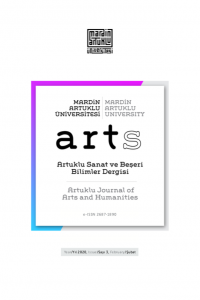Abstract
In this study, the playful rhetoric which was put forward as a critical method in the area of art in Europe as of the late 19th century has been addressed. This rhetoric which was developed by Avant-garde art movements of the 20th century has been discussed via examples particularly on the basis of certain art practices appertaining to Dada and Surrealism movements which spearheaded the process. These critical attitudes which gave rise to radical changes in terms of style and content in the area of art have been analyzed also in the context of discussions set forth in the field of linguistics and semiotics. It has been stated that an ironic and playful narration method was placed at the hearth of linguistic structure as per this critical rhetoric which was proposed by Avant-garde art movements in order to criticize conventional styles of narration and representation. It has been suggested that this narration method which was predicated on the idea of a free intersemiotic montage was executed on the basis of relationality and identity notions which gave freedom to use metaphors. On the other hand, in this study, it has been asserted that this critical rhetoric which was alleged to be building up as part of the Deconstructivist approach of Post-structuralist understanding also gave birth to Post-modern art understanding.
References
- Altınörs, A. (2011). Platon Ile Aristoteles’in Retorik. Ekev Akademi Dergisi yıl: 2015 sayı: 49, 81-93
- Antmen, A. (2008). 20. Yüzyıl Batı Sanatında Akımlar. İstanbul: Sel.
- Artun, N. A. (2014). Sürrealizm Mimarlık Mekan Sanatı. İstanbul: İletişim.
- Dellaloğlu, Besim F. (1995). Frankfurt Okulu’nda Sanat ve Toplum, İstanbul: Bağlam.
- e-skop (2016, 16 Nisan). Dadanın 100. Yılı: Tristan Tzara ve Dada Manifestosu. https://www.e-skop.com/skopbulten/dadanin-100-yili-tristan-tzara-ve-dada- manifestosu/2915. Erişim Tarihi: 15 Kasım 2019
- Foucault, M. (2015). Kelimeler ve Şeyler. Ankara: İmge Kitabevi.
- Gadamer, H. G. (2008). Hakikat ve Yöntem. İstanbul: Paradigma.
- Lynton, N. (2004). Modern Sanatın Öyküsü (Ç. S. Öziş, C. Çapan). İstanbul: Remzi Kitabevi.
- Sarup, M. (2010). Post-yapısalcılık ve Postmodernizm (Ç. A. Baki Güçlü). İstanbul: Kırk gece
- Tunalı, İ. (2015). Çağdaş Sanat Felsefesi. İstanbul: Remzi Kitabevi.
- e-skop. https://www.e-skop.com/skopbulten/dadanin-100-yili-tristan-tzara-ve-dada- manifestosu/2915
Abstract
Bu çalışmada 19. yüzyılın sonlarından itibaren Avrupa’da sanat alanında oyunsal bir retorik ile gerçekleştirilen eleştirel dil üzerinden değişen temsil anlayışı ve anlatı biçimleri ele alınmıştır. 20. yüzyıl Avangard sanat hareketleri tarafından ortaya konan bu eleştirel yaklaşımlar burada, özellikle sürece öncülük eden Dada ve Sürrealizm akımlarına ait bazı sanat pratikleri üzerinden örneklendirilerek tartışılmıştır. Sanat alanında biçim ve içerik bağlamında radikal değişimlere neden olan bu eleştirel tutumlar aynı zamanda dilbilim ve göstergebilim alanında ortaya konan tartışmalar kapsamında ele alınmıştır. Avangard sanat hareketlerinin geleneksel anlatı ve temsil biçimlerini eleştirmek amacıyla ortaya koydukları bu eleştirel retoriğe göre dilsel yapının merkezine ironik ve oyunsal bir anlatı yöntemi konulduğu belirtilmiştir. Göstergeler arası özgür bir montaj fikrine dayandırılan bu anlatı yöntemi ise metafor kullanımında özgür bir ilişkisellik ve özdeşlik fikrine dayandırılarak gerçekleştirildiği belirtilmiştir. Öte yandan bu çalışmada, Post-yapısalcı anlayışın Yapı-sökümcü yaklaşımının bir parçası olarak geliştiği belirtilen bu eleştirel retoriğin aynı zamanda Postmodern sanat anlayışına da kaynaklık ettiği belirtilmiştir.
References
- Altınörs, A. (2011). Platon Ile Aristoteles’in Retorik. Ekev Akademi Dergisi yıl: 2015 sayı: 49, 81-93
- Antmen, A. (2008). 20. Yüzyıl Batı Sanatında Akımlar. İstanbul: Sel.
- Artun, N. A. (2014). Sürrealizm Mimarlık Mekan Sanatı. İstanbul: İletişim.
- Dellaloğlu, Besim F. (1995). Frankfurt Okulu’nda Sanat ve Toplum, İstanbul: Bağlam.
- e-skop (2016, 16 Nisan). Dadanın 100. Yılı: Tristan Tzara ve Dada Manifestosu. https://www.e-skop.com/skopbulten/dadanin-100-yili-tristan-tzara-ve-dada- manifestosu/2915. Erişim Tarihi: 15 Kasım 2019
- Foucault, M. (2015). Kelimeler ve Şeyler. Ankara: İmge Kitabevi.
- Gadamer, H. G. (2008). Hakikat ve Yöntem. İstanbul: Paradigma.
- Lynton, N. (2004). Modern Sanatın Öyküsü (Ç. S. Öziş, C. Çapan). İstanbul: Remzi Kitabevi.
- Sarup, M. (2010). Post-yapısalcılık ve Postmodernizm (Ç. A. Baki Güçlü). İstanbul: Kırk gece
- Tunalı, İ. (2015). Çağdaş Sanat Felsefesi. İstanbul: Remzi Kitabevi.
- e-skop. https://www.e-skop.com/skopbulten/dadanin-100-yili-tristan-tzara-ve-dada- manifestosu/2915
Details
| Primary Language | Turkish |
|---|---|
| Journal Section | Research Article |
| Authors | |
| Publication Date | February 26, 2020 |
| Published in Issue | Year 2020 Issue: 3 |
ARTS is licensed under CC BY-NC 4.0
PUBLISHER | JOURNAL BOARDS | INDEXES | PRICE POLICY | STATISTICS | MIAR | SHERPA ROMEO

